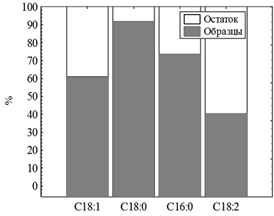FATTY ACID COMPOSITION OF NIGELLA SATIVA L. SEED OIL INTRODUCED IN DAGESTAN
UDC 615.19.072
Abstract
Nigella sativa L. is an annual herbaceous plant grown not only as an ornamental plant, but also has been used in folk medicine. N. sativa seeds are a source of biologically active substances. This paper provides an analysis of the quantitative content of fatty acids in samples of various ecological and geographical origin. It is shown that seeds grown in Dagestan are characterized by a relatively high content of fatty oil. The characteristics of the qualitative and quantitative composition of fatty acids, depending on their origin, are given. The highest content of linoleic and stearic fatty acids was found in the sample from Egypt. Palmitic acid was the highest in the sample from Saudi Arabia, and oleic acid was the highest in the sample from Azerbaijan. The revealed differences in the fat content are of great importance, since samples for breeding purposes can be selected on their basis. In particular, the sample from Azerbaijan showed relatively high levels of oleic acid, which generally contributes to the increase in the antioxidant activity of vegetable oil and lengthens of the keeping period.
Downloads
Metrics
References
Islam M.T., Roich Khan Md., Mishra S.K. Oriental Pharmacy and Experimental Medicine, 2019, vol. 19, pp. 115–129. DOI: 10.1016/S1875-5364(16)30088-7.
Enomoto S., Assano R., Iwahori Y., Narui T., Okada Y., Singab A.N., Okuyama T. Biol. Pharm. Bull., 2001, vol. 24, no. 3, pp. 307–310.
Asilbekova D.T., Bobakulov Kh.M. Khimiya rastitel'nogo syr'ya, 2021, no. 1, pp. 105–112. (in Russ.).
Khazdair M.R., Ghafari S., Sadeghi M. Pharm. Biol., 2021, vol. 59, no. 1, pp. 696–703. DOI: 10.1080/13880209.2021.1931353.
Benkaci-Ali F., Baaliouamur A., Wathelet J.P., Marlier M. Chem. Nat. Compd., 2012, vol. 47, no. 6, pp. 925–931.
Piras A., Rosa A., Marongiu B., Porcedda S., Falconieri D., Dessi M.A., Ozcelik B. Koca U. Industrial Crops and Products, 2013, vol. 46, pp. 317–323.
Datta A.K., Saha A., Bhattacharya A., Mandal A., Paul R., Sengupta S. J. Plant Dev Sci., 2012, vol. 4, pp. 1–43.
Fes'kova Ye.V., Ignatovets O.S., Tychina I.N., Savich I.M., Svityashchuk D.S. Trudy BGTU. Seriya 2, 2018, no. 2, pp. 167–170. (in Russ.).
Rud' N.K., Sampiyev A.M., Davitavyan N.A. Nauchnyye vedomosti Belgorodskogo gosudarstvennogo universiteta, 2013, no. 25, pp. 207–212. (in Russ.).
Salehi B., Quispe C., Imran M., Ul-Haq I., Živković J., Abu-Reidah I.M., Sen S., Taheri Y., Acharya K., Azadi H., Del Mar Contreras M., Segura-Carretero A., Mnayer D., Sethi G., Martorell M., Abdull Razis A.F., Sunusi U., Kamal R.M., Rasul Suleria H.A., Sharifi-Rad J. Frontiers in Pharmacology, 2021, vol. 12, pp. 1–26. DOI: 10.3389/fphar.2021.625386.
Pop R.M. Future Perspectives on Nigella sativa: Characterization and Pharmacological Properties. Series: Herbs and Herbalism. New York: Nova Biomedical, 2018, 280 р.
Ijaz H., Tulain U.R., Qureshi J., Danish Z., Musayab S., Akhtar M.F., Saleem A., Khan K.K., Zaman M., Waheed I., Khan I., Abdel-Daim M. Pak. J. Pharm. Sci., 2017, vol. 30, no. 1, pp. 229–234.
Sultana S., Asif H.M., Akhtar N., Iqbal A., Nazar H., Rehman R.U. Journal of Pharmacognosy and Phytochemistry, 2015, vol. 4, no. 4, pp. 103–106.
Wajs A., Bonikowski R., Kalemba D. Flavour and Fragrance Journal, 2008, vol. 23, no. 2, pp. 126–132. DOI: 10.1002/ffj.1866.
D’Antuono L.F., Moretti A., Lovato A.F.S. Industrial Crops and Products, 2002, vol. 15, pp. 59–69.
Nergiz C., Otles S. Food chemistry, 1993, pp. 259–261.
Dospekhov B.A. Metodika polevogo opyta: s osnovami statisticheskoy obrabotki rezul'tatov issledovaniy. [Methodolo-gy of field experience: with the basics of statistical processing of research results]. Moscow, 1979, 416 p. (in Russ.).
Abdolrahimi B. Int. J. of AgriScience, 2012, vol. 2, no. 1, pp. 93–101.
Tonçer1 Ö., Kizil S. International Journal of Agriculture & Biology, 2004, no. 6(3), pp. 529–532.
Talafih K.A., Haddad N.I., Hattar B.I., Kharallah K. Jordan Journal of Agricultural Sciences, 2007, vol. 3, no. 4, pp. 385–397.
Daukśas E., Venskutonis P.R., Sivik B. Journal of food science, 2002, vol. 67, no. 3, pp. 1021–1024.
Lakin G.F. Biometriya. [Biometrics]. Moscow, 1973, 343 p. (in Russ.).
Sizova T.M. Statistika: uchebnoye posobiye. [Statistics: textbook]. St. Petersburg, 2005, 80 p. (in Russ.).
Kiralan M., Özkan G., Bayrak A., Ramadan M.F. Industrial Crops and Products, 2014, vol. 57, pp. 52–58.
Shcherbakov V.G. Biokhimiya i tovarovedeniye maslichnogo syr'ya. [Biochemistry and commodity science of oilseed raw materials]. Moscow, 1969, 454 p. (in Russ.).

Copyright (c) 2023 chemistry of plant raw material

This work is licensed under a Creative Commons Attribution 4.0 International License.

This work is licensed under a Creative Commons Attribution 4.0 International License.
The authors, which are published in this journal, agree to the following conditions:
1. Authors retain the copyright to the work and transfer to the journal the right of the first publication along with the work, at the same time licensing it under the terms of the Creative Commons Attribution License, which allows others to distribute this work with the obligatory indication of the authorship of this work and a link to the original publication in this journal .
2. The authors retain the right to enter into separate, additional contractual agreements for the non-exclusive distribution of the version of the work published by this journal (for example, to place it in the university depository or to publish it in a book), with reference to the original publication in this journal.
3. Authors are allowed to post their work on the Internet (for example, in a university repository or on their personal website) before and during the review process of this journal, as this may lead to a productive discussion, as well as more links to this published work.











